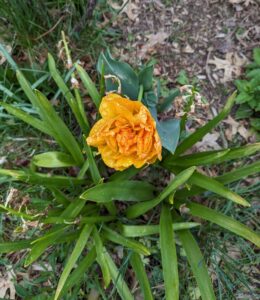 This morning I woke up and looked out the window to see five deer exiting my neighbor’s yard for a foray into the gardens across the street. My first thought was that the deer looked rather well-fed, probably as the result of dining on plants in my garden. I raced outside to take inventory of the damage. The first plant that I checked was a beautiful double tulip called ‘Charming Beauty’. It looks almost like a small peony, with an opulent display of golden yellow petals. Fortunately, the deer ignored it, undoubtedly swayed by the large number of tasty hosta shoots now emerging from the ground.
This morning I woke up and looked out the window to see five deer exiting my neighbor’s yard for a foray into the gardens across the street. My first thought was that the deer looked rather well-fed, probably as the result of dining on plants in my garden. I raced outside to take inventory of the damage. The first plant that I checked was a beautiful double tulip called ‘Charming Beauty’. It looks almost like a small peony, with an opulent display of golden yellow petals. Fortunately, the deer ignored it, undoubtedly swayed by the large number of tasty hosta shoots now emerging from the ground.
Some years I long for simplicity and opt for single forms of spring-blooming plants like daffodils, tulips and hyacinths. Last fall I needed abundance, and picked double-flowered varieties. Now all my doubles are either in bloom or close to it. Needless to say, I am going out with the deer spray every day because opulence consumed—by deer–is opulence denied. Also, with the price of tulips being rather high, I am protecting my investment.
The original double tulips were probably genetic mutations. At least one source says that these mutated flowers were discovered by European plant hunters in Asia the seventeenth century. This is probably true, though it’s highly likely that the locals in the area where the double tulips were “discovered” knew about them much sooner. These days, doubles often appear as “sports” or spontaneous mutations of single varieties. For example, ‘Double Foxtrot’, with its peachy pink blooms, is a sport of the single-flowered ‘Foxtrot’.
A normal tulip has six colorful petals. Doubles may feature two or three times that number. The color range is the same as for single-petaled varieties—from pure white through a range of colors, excluding true blue and absolute black. Varieties like ‘Dark Hero’ are actually a heroic shade of darkest maroon purple. “Blue” doubles, like ‘Blue Spectacle’ are vivid blue-purple. Like roses and many other flowering plants, tulips do not have the gene for true blue color. This does not deter breeders, however, and marketers will persist in using terms like “blue” and “black” to describe plants that look very different in the garden.
At least two standard tulip categories, “Early Doubles” and “Peony-Flowered” contain double-flowered varieties. The “Early Doubles”, including beauties like white-flowered ‘Mondial’ and yellow ‘Marie Jo’, generally emerge in mid April. Towards the end of the month, the peony-flowered varieties, like the elaborately red and white-striped ‘Carnival de Nice’ break into glorious bloom. If you like the orange and red-flared ‘Princess Irene’, you may also want the peony-flowered offspring, ‘Orange Princess’. It is fun sometimes to grow a single flowered variety alongside its double-flowered “child”.
Parrot tulips, with their ruffled, dramatically colored petals, look like doubles, but generally are not. However, if you want Russian oligarch-type opulence, you might invest in some anyway.
Is there a wrinkle in the exquisite fabric of the double-flowered tulip? Yes, if you like tulips that perennialize. Double-flowered varieties generally do not, and, as with many other tulips, are best treated as annuals. If you want to try for repeat performances, lift the bulbs after the foliage has dried out and store them in a cool dry place. Replant the bulbs in the fall and hope for the best. While you are hoping, install some fresh bulbs just to be on the safe side.
Doubles are widely available from merchandisers in the fall, but many online/catalog vendors are beginning to take orders now for fall delivery. Try John Scheepers at 23 Tulip Drive, P.O. Box 638, Bantam, CT 06750; Tel. 860-567-0838; www.johnscheepers.com. Print catalog available.
While you are at it, think about garden marauders in your area. You may want to lay in an extra supply of deer repellent.
